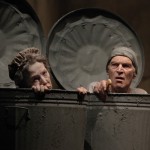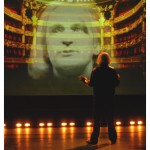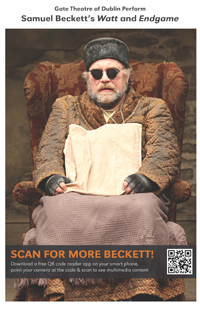The audacity of WATT
 “If we can’t keep our genres more or less distinct, or extricate them from the confusion that has them where they are, we might as well go home and lie down.” This is a clearly unamused Samuel Beckett, protesting to his American publisher Barney Rosset that his play Act Without Words absolutely must not be filmed. In another missive to Rosset, referring to his radio play All That Fall, Beckett sounds even more unequivocal: “I am absolutely opposed to any form of adaptation with a view to its conversion into ‘theatre’…to ‘act’ it is to kill it.”
“If we can’t keep our genres more or less distinct, or extricate them from the confusion that has them where they are, we might as well go home and lie down.” This is a clearly unamused Samuel Beckett, protesting to his American publisher Barney Rosset that his play Act Without Words absolutely must not be filmed. In another missive to Rosset, referring to his radio play All That Fall, Beckett sounds even more unequivocal: “I am absolutely opposed to any form of adaptation with a view to its conversion into ‘theatre’…to ‘act’ it is to kill it.”
This is certainly one way to underline the audacity of Barry McGovern’s solo-performance distillation of Samuel Beckett’s novel Watt, coming to the stage this weekend as part of Gate Theater Dublin’s visit to Ann Arbor. In its original form, Watt, Beckett’s spare, hilarious, and bizarre black comedy—written during World War II but deemed unpublishable until 1953—is a 250-page narrative puzzle with its own idiosyncratic internal rhythm and strength of purpose. The novel even ends, cheekily, with the statement “No symbols where none intended,” as if to ward off any independent-minded future interpretations.
So yes, Beckett preached genre purity, even if he didn’t always practice it. (He gave grudging permission for others to adapt his work, and occasionally even supervised such adaptations.) But, in his book Samuel Beckett: Repetition, Theory and Text, critic Steven Connor notes a “principle of transferability” at work in Beckett’s prose, especially in his later years, after he had begun writing medium-specific works for television and radio:
The close attention to details of space and position in the related texts…as well as the theatrical language often used in these works, often suggests a doubling of medium, as though the texts included within themselves the possibility of their staging in some other theatrical form.
Anyone who has seen Beckett performed knows this to be demonstrably true. The chilly nakedness of his prose, his elemental plotting, and an aesthetic that suggests the abolishment of space and time, have always lent themselves to imaginative interpretation. A 2008 Gate Theater staging of Eh Joe, which Beckett originally wrote for television, stranded a silent Liam Neeson alone onstage, listening to a woman’s recorded voice, while a big screen behind him displayed an increasingly magnified live video image of his face. Director Atom Egoyan, the celebrated filmmaker, conceived of the idea when realizing that Neeson’s role is “the longest reaction shot than an actor can imagine.”
If, per Watt, “to elicit something from nothing requires a certain skill,” then eliciting something from something else requires, at the very least, a kind of reckless ambition. If adapting from the page to the stage, this eliciting might compel an attendance to the visuality of the text. For Raymond Federman, the French-American writer and academic who made his career at the University of Buffalo—and died in 2009—Beckett was less a writer than “a great painter…who painted tableaux (or tableaus) with words.” In his 2000 lecture “The Imagery Museum of Samuel Beckett,” he encouraged readers to look at Beckett’s books “like tourists look at paintings on the walls of a museum or exhibit.” Federman finds Watt to be “full of such absurd surrealistic pictures,” and discovers within the novel a description of a quite literal painting, hanging on the wall in Erskine’s room, that Federman suggests as “Beckett’s best explanation of his own work.” Watt, who knows nothing about painting and nothing about physics, narrows down his own understanding of the painting’s content—to say nothing of its potential symbolism—to the following possibilities:
“a circle and its centre in search of each other,
or a circle and its centre in search of a centre and a circle respectively,
or a circle and its centre in search of its centre and a circle respectively,
or a circle and its centre in search of a centre and its circle respectively,
or a circle and a centre not its centre in search of its centre and its circle respectively,
or a circle and a centre not its centre in search of a centre and a circle respectively,
or a circle and a centre not its centre in search of its centre and a circle respectively
or a circle and a centre not its centre in search of a centre and its circle respectively…”
We might as well go home and lie down.
11/12 International Theater Series
This year’s International Theater Series features three productions at the Power Center. The series begins with Ireland’s acclaimed Gate Theater Company performing a double-bill of two one-act plays by Samuel Beckett, Endgame and Watt. As previously announced, the series continues with Einstein on the Beach, the seminal opera by Philip Glass and Robert Wilson with choreography by Lucinda Childs. Considered one of the most remarkable performance works of our time, this performances launches a world tour of what will likely be the last reconstructions of this work designed and led by its original creators. Closing the series is The Andersen Project, a solo performance created by Canadian theater visionary Robert Lepage and performed by Yves Jacques that explores sexual identity, unfulfilled fantasies, and the thirst for recognition and fame through Hans Christian Andersen’s timeless fables.
Subscription packages go on sale to the general public on Monday, May 9, and will be available through Friday, September 17. Current subscribers will receive renewal packets in early May and may renew their series upon receipt of the packet. Tickets to individual events will go on sale to the general public on Monday, August 22 (via www.ums.org) and Wednesday, August 24 (in person and by phone). Not sure if you’re on our mailing list? Click here to update your mailing address to be sure you’ll receive a brochure.
Samuel Beckett’s Endgame and Watt
Gate Theatre of Dublin
Michael Cogan, director
Thursday, October 27, 7:30 pm
Friday, October 28, 8 pm
Saturday, October 29, 8 pm
Power Center
Straight from Ireland comes the Gate Theatre, largely considered the interpreter of Beckett in the world. Endgame, like Waiting for Godot, is considered one of Beckett’s most important works, written in a style associated with the Theatre of the Absurd. The bizarre adventures of Watt (a novel written while Beckett was in hiding during World War II) and his struggles to make sense of the world around him is told with elegant simplicity, immense pathos, and explosive humor. This week-long residency will be accompanied by a week-long festival of the complete Beckett works on film.

Philip Glass & Robert Wilson’s Einstein on the Beach
Lucinda Childs, choreographer
Friday, January 20, 7pm
Saturday, January 21, 7pm
Sunday, January 22, 2pm
Power Center
“The most beautiful thing we can experience is the mysterious.” — Albert Einstein
Widely credited as one of the greatest artistic achievements of the 20th century, this rarely-performed work will be reconstructed for a major international tour (including the first North American presentations ever held outside of New York City) nearly four decades after it was first performed and 20 years since its last production. Non-narrative in form, the work uses a series of powerful recurrent images as its main storytelling device, shown in juxtaposition with abstract dance sequences created by American choreographer Lucinda Childs. Prior to the production’s final technical rehearsals and world premiere in Montpelier, France, UMS will host the creators, musicians, performers, and crew for Einstein for three weeks as they reconstruct and rehearse the work for what is likely to be the final world tour designed and led by its creators. These early preview performances will be the only opportunity to see Einstein on the Beach in the Midwest.
Click the video below to watch some excerpts from Einstein on the Beach with audio commentary from collaborator Robert Wilson.
The Andersen Project
Ex Machina
Robert Lepage, artistic director
Thursday, March 15, 7:30 pm
Friday, March 16, 8 pm
Saturday, March 17, 8 pm
Power Center
Filled to the brim with his trademark humor and visual and technological brilliance, this off-the-wall masterpiece by Canadian theater visionary Robert Lepage stars Yves Jacques (Far Side of the Moon) in a one-man tour-de-force about a Canadian writer from the rock-and-roll milieu who is unexpectedly commissioned by the Opera Garnier in Paris to write a libretto for a children’s opera. Freely inspired by the timeless fables written by Hans Christian Andersen, who as it turns out, didn’t really like children, as well as anecdotes from the author’s personal diaries, The Andersen Project keenly explores unraveling relationships, personal demons, the thirst for recognition, and compromise that comes too late.

Return to the complete chronological list.
Gate Theatre Dublin Coverage Round Up
Thanks for Scanning!
UMS presents The Gate Theatre Dublin performances (opening night Thursday, 10/27!).
Your reading options!
Leslie Stainton’s Q&A with Gate Artistic Director Michael Colgan Topics covered: Do actors think of Beckett as a sadist? Is theatre the art of loss? And what of Beckett’s genius?
UMS Residency Coordinator Mary Roeder’s highly-entertaining backstage preview: No Rest for the Wicked…..or The Gate Theatre Company Dublin
Akiva Gottlieb, a PhD student and instructor in English Language and Literature at the University of Michigan, writes about Beckett’s only film, Film (Spoiler: it’s 20 minutes long & the only audible dialogue is one “shhhh!”)
Akiva Gottlieb on the audacity of Watt



